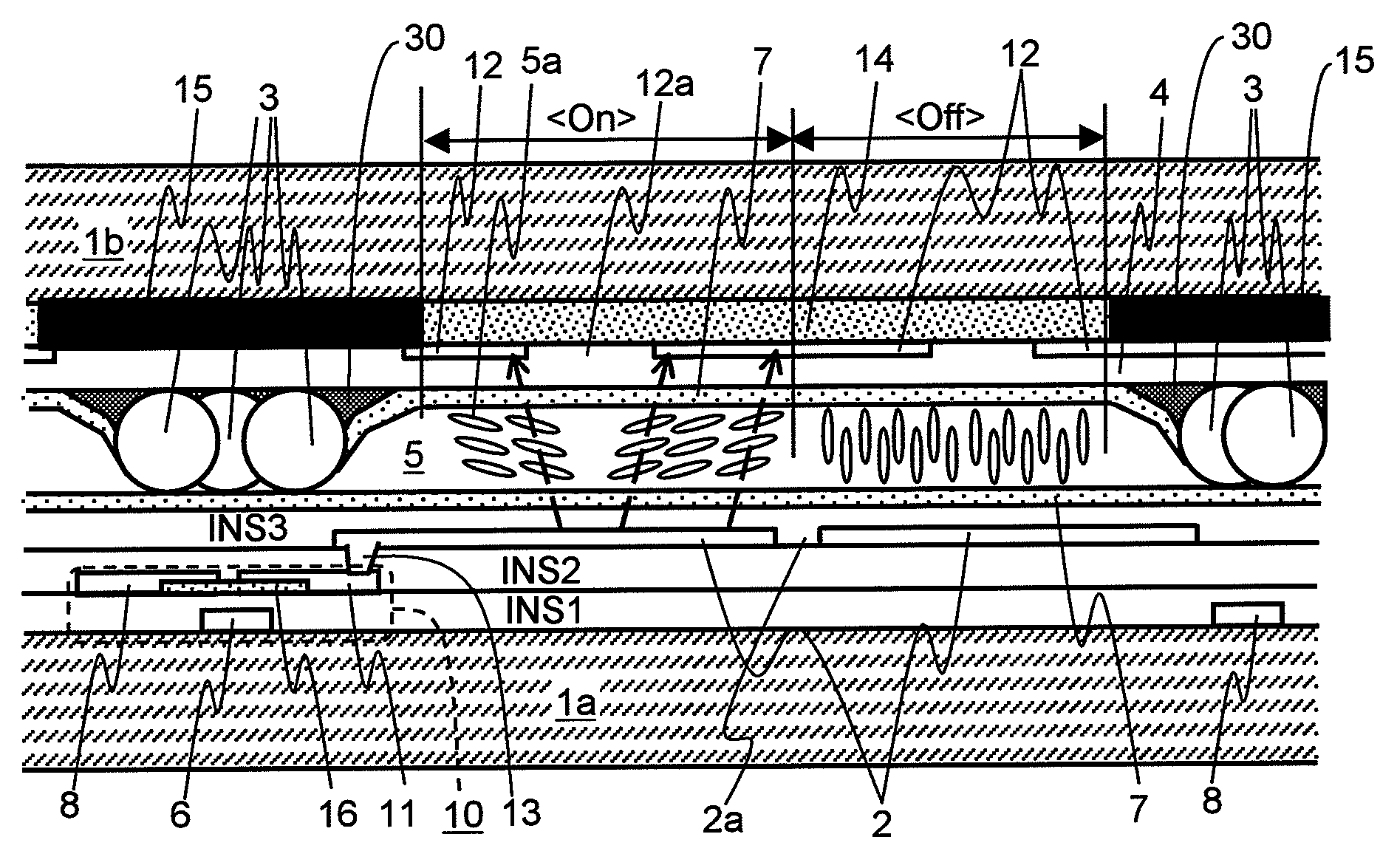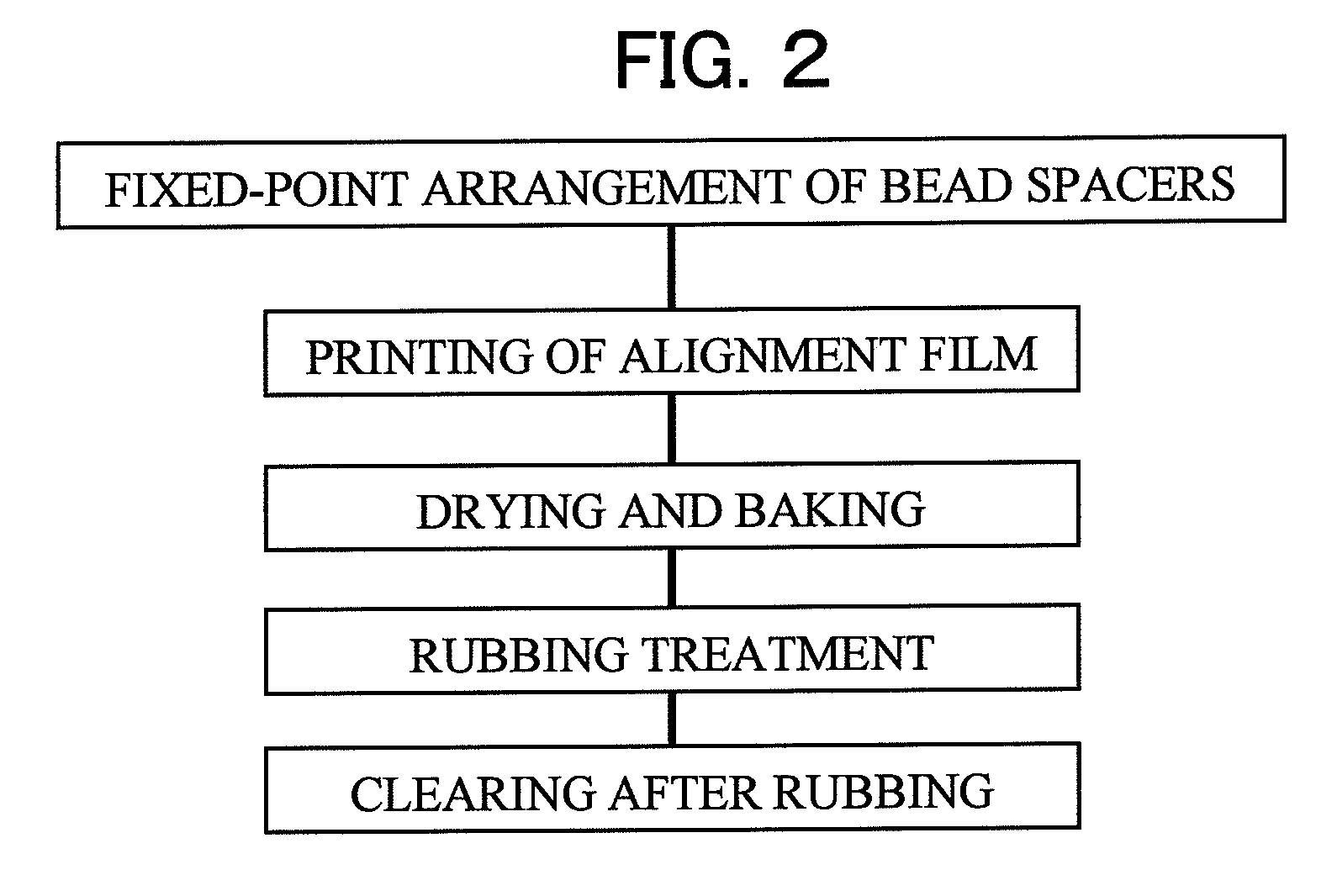Liquid crystal display device and method of manufacturing the same
a liquid crystal display and structure technology, applied in the manufacture of electrode systems, electric discharge tubes/lamps, instruments, etc., can solve the problems of insufficient fixing strength of bead spacers and prone to move into effective pixels, so as to prevent faulty display, reduce the rate of occurrence of defective products, and improve the bonding force of bead spacers to the substrate of liquid crystal display devices
- Summary
- Abstract
- Description
- Claims
- Application Information
AI Technical Summary
Benefits of technology
Problems solved by technology
Method used
Image
Examples
first embodiment
[0060]Principal constituent elements of a liquid crystal display device according to the present invention will be described in detail before the detailed descriptions of a structure of the liquid crystal display device according to the present invention and a method of manufacturing the same, to make features of the present invention clear, which will be described later.
Material of Bead Spacer 3
[0061]A spherical or cylindrical “piece (chip)” used as a spacer is made of an inorganic material such as silica or an organic material such as plastic. The piece made of the organic material is also called a plastic bead. In particular, the piece made of an organic polymer has a suitable hardness such that a resin layer, such as an alignment layer which is brought into contact therewith, is not damaged, easily follows a change in thickness which is caused by thermal expansion or thermal shrinkage, and has a relatively small movement inside the liquid crystal display device. The organic poly...
example 1
[0093]In order to prevent the shift of the bead spacers 3, according to the present invention, the surface tension of the high-boiling solvent contained in the spacer dispersion liquid is made higher than the surface tension of the precursor solution 7′ of the alignment film, so the bead spacers 3 are held to the light shielding region of the principal surface of the CF substrate 1b or the TFT substrate 1a by a residue of the spacer dispersion liquid. The spacer dispersion liquid landed on the principal surface of the substrate (CF substrate 1b) is evaporated to some extent before the precursor solution 7′ of the alignment film is applied to the principal surface thereof. A part of the spacer dispersion liquid is left on the principal surface of the substrate. The residue of the spacer dispersion liquid corresponds to the part of the spacer dispersion liquid left on the principal surface of the substrate immediately before the precursor solution 7′ is applied to the principal surfac...
example 2
[0106]The following method will be described as another example to solve the technical problems with reference to FIGS. 7A to 7D. In this method, as shown in FIG. 6a, the alignment film 7 is disposed on the principal surface of the substrate (CF substrate 1b) and then the bead spacers 3 are disposed on the alignment film 7 (portions covering the light shielding film 15) by an ink jet method.
[0107]According to such a method, the bead spacers 3 are not moved by the precursor solution 7′ of the alignment film. However, the “shift of the bead spacers 3” which are dropped on the alignment film 7 (principal surface of the CF substrate 1b) or the “shift of the bead spacers 3” which is caused by the flow of a liquid crystal material injected to a space (cell gap) between the pair of substrates 1 bonded opposite to each other emerges as a new problem. The bead spacers 3 are in contact with the liquid crystal material, so the fixation of the bead spacers 3 to the alignment film 7 using an adh...
PUM
| Property | Measurement | Unit |
|---|---|---|
| viscosity | aaaaa | aaaaa |
| viscosity | aaaaa | aaaaa |
| surface tension | aaaaa | aaaaa |
Abstract
Description
Claims
Application Information
 Login to View More
Login to View More - R&D
- Intellectual Property
- Life Sciences
- Materials
- Tech Scout
- Unparalleled Data Quality
- Higher Quality Content
- 60% Fewer Hallucinations
Browse by: Latest US Patents, China's latest patents, Technical Efficacy Thesaurus, Application Domain, Technology Topic, Popular Technical Reports.
© 2025 PatSnap. All rights reserved.Legal|Privacy policy|Modern Slavery Act Transparency Statement|Sitemap|About US| Contact US: help@patsnap.com



